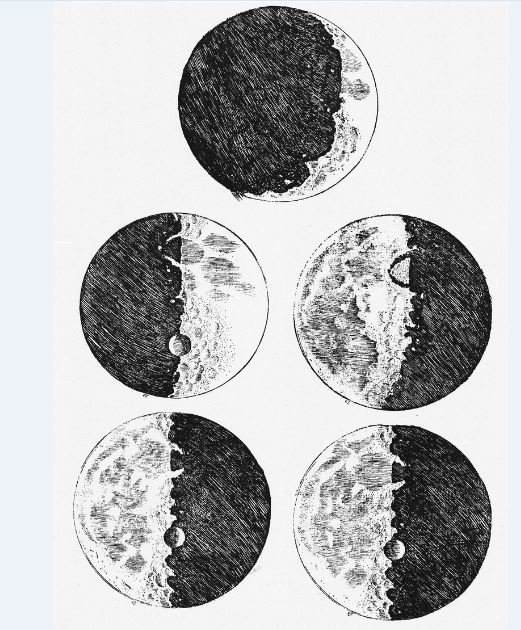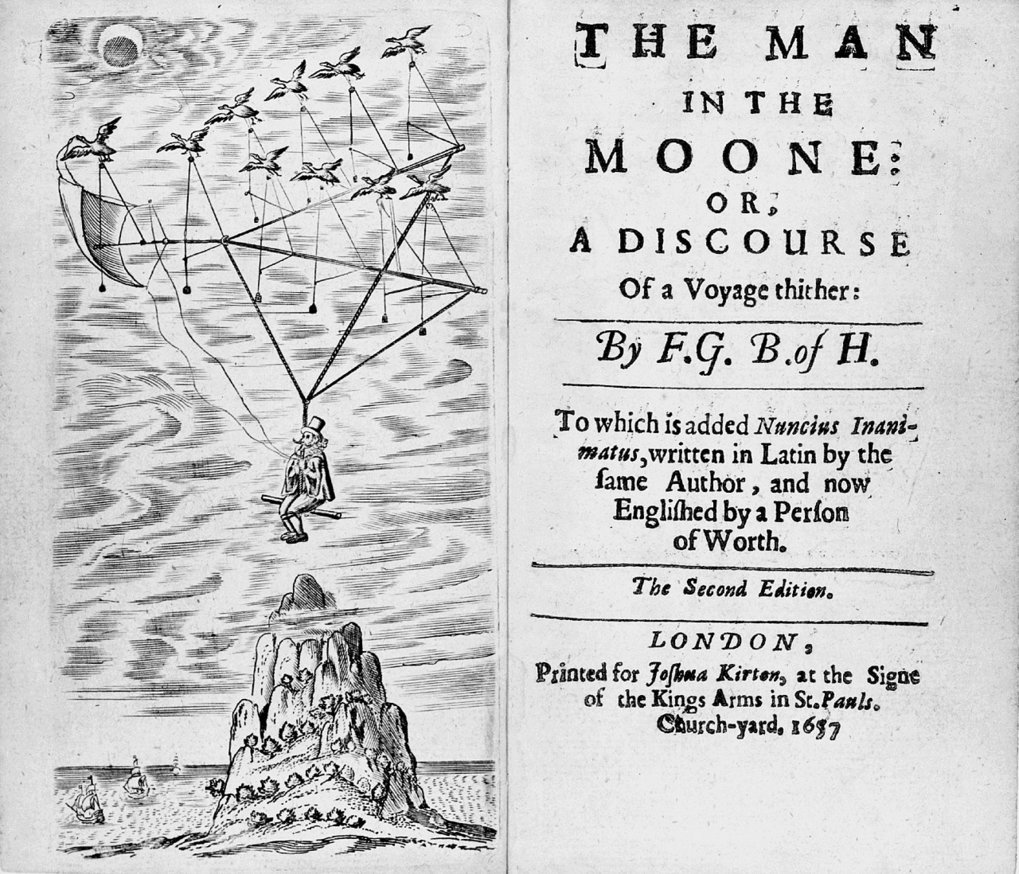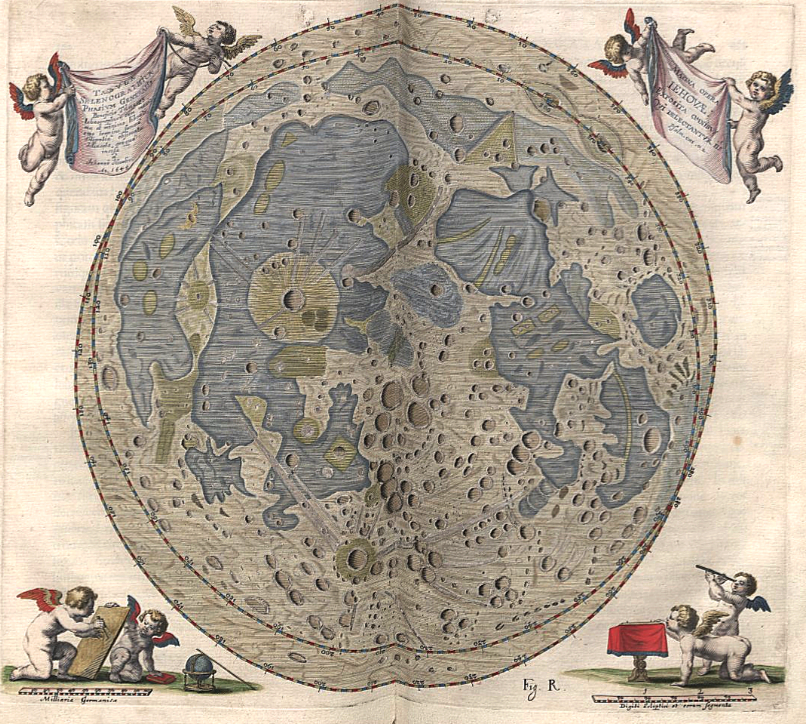How 17th century dreamers planned to reach the moon
People have been dreaming about space travel for hundreds of years, long before the arrival of the spectacular technologies behind space exploration today – mighty engines roaring fire and thunder, shiny metal shapes gliding in the vastness of the universe.
Glimpse of a second Earth: Galileo’s sketches of the moon, 1610.
Text:
We’ve only travelled into space in the last century, but humanity’s desire to reach Earth’s satellite is far from recent. In the second century AD, Lucian of Samosata’s True History a satirical travel fantasy, pictured a group of adventure seekers taken up into the air by a whirlwind for seven days and nights and finally thrown onto the moon, straight into the turbulence of lunar politics – a military conflict. For the king of the moon is embroiled in a colonial war with the king of the sun over the morning star.
And much earlier than any beep of a satellite, people did not only dream of travelling to moon, they were given real, serious thought on possible ways to reach Earth’s satellite. The first relevant technical reckoning can be found in the 17th century.
This was inspired by astronomic discoveries. For a long time, it was thought that the world was encapsulated with in which nested celestial bodies. But then Galileo managed to compile enough observational data to support Copernicus’s theory of heliocentrism. This meant that the moon began, for the first time, to be considered an opaque, Earth-like object.
The novel view of the solar system is closely linked to the use of the telescope. The instrument literally provided a changed view of the universe, transforming it into an object of Earthly science that can be experienced and explored through rules and laws. Galileo Galilei reassembled the telescope, probably invented in Holland in 1608, and turned it towards the sky. He observed the moon, the stars, and the Milky Way. And he discovered Jupiter’s four moons – which led him to the bold conclusion that they orbit their mother planets in the same way as the planets (and even the Earth) orbit their sun.

Flying to the moon with geese: frontispiece from The Man in the Moone, Francis Godwin (1562-1633).
Galilei regarded the moon as something like a “second earth”. His work Sidereus Nuncius (“,” or “Message from the Stars”), published by Galileo in 1610, even contained some sketches of the eerie moon relief with the previously known “large or old spots”, as Galileo called them, and the “small spots” discovered by him, the craters.
These insights also found their way into literature. In 1620, Ben Jonson’s masque was performed before King James I, entertaining the court with satire but also elucidating the newest astronomical viewpoints.
It was in the context of this moon fervour that John Wilkins, a 24-year-old graduate of Oxford University, published in 1638 the first edition of his book . The book popularised Galileo’s description of the moon as a solid and habitable world.
When preparing the much edited and lengthened second edition of the Discovery, eventually published in 1640, Wilkins was impressed by Francis Godwin’s story , also appearing in 1638, in which a character named Domingo Gonzales is transported to the moon in a chariot towed by a flock of geese.
After reading this piece of 17th century science fiction, Wilkins assumed that not only must occasional travel to the moon be possible, but also regular visits and habitation. The moon was the ultimate travelling destination of his time, and moon travel a technological achievement pushing the historical and providential limits for mankind.
Appreciating various fictional scenarios, Wilkins aimed to “raise up some spirits eminent for new attempts and strange inventions” and to contemplate practical ways of “bringing the moon closer” by travelling through space. In the pragmatic tone of an artisan, the second edition of the Discovery ruminates on the technicalities: “I do seriously, and upon good grounds, affirm it possible to make a flying chariot. Wilkins describes and designs various flying apparatuses driven by manpower, or towed by exotic birds, and even imagines an engine to be contrived on the same principles as the legendary mechanical doves and eagles.

Cosmic landscape: map of the moon engraved by the astronomer Johannes Hevelius, 1645.
The author was also alerted to the challenges of moon travel, and even expressed a slight vexation that divine providence did not endow the human body with any natural means of flying. Enumerating the impediments to flight from the Earth, he humorously warns that there won’t be any “castles in the air to receive poor pilgrims, or errant knights”. He discusses the nature of gravity, how difficult it would be to bring food and water to the moon, and to survive the cold and thin lunar air.
But Wilkins also states with perfect assurance that the ways of conveyance through space would eventually be discovered. He predicts that “as soon as the art of flying is found out”, humans “will make one of the first colonies, that shall transplant into that other world”, all glorifying the future of air travel.
The Discovery ends with Wilkins prophesying that posterity will likely be surprised at the ignorance of his age. But this isn’t the feeling kindled in his modern readership, although many of his conclusions about the moon are indeed mistaken. Even though his answers were premature, our contemporary investigations of the moon still follow the same trajectory of questions as did his Space Odyssey 1640: the presence of water, the possibilities for regular travel and colonisation. Young John Wilkins meant to provoke the readers’ curiosity concerning “secret truths” about nature – a purpose he successfully fulfilled.
Space explorations tend to be viewed primarily as manifestations of spectacular and, alas, costly technologies. Is this not the reason why the moon flight program has been ? In the 17th century, motivation to design the means of travel to the moon was similar to our contemporary stimuli for space exploration as they were formulated at the dawn of the Apollo spaceflight program. People dream of pushing the boundaries of humankind and of bringing to life a great deal of useful knowledge.
After all, it is not only machinery that drives human beings into space, but humanity’s curiosity and imagination prompting the desire to reach beyond the possible.








